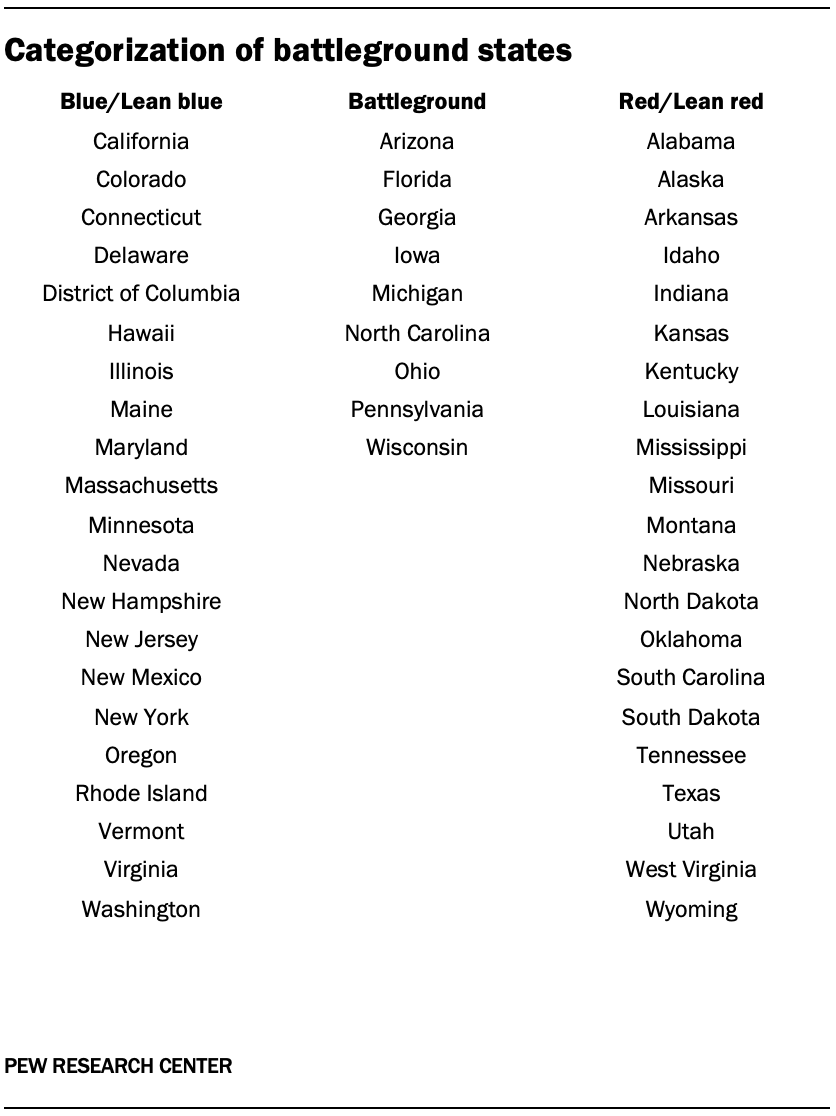Categorization of battleground states in this report
 To identify battleground states for the November presidential election, researchers consulted several experts’ forecasts (including Larry Sabato’s Crystal Ball, the Cook Political Report, Inside Elections and Nate Cohn’s New York Times ratings) to come up with a categorization of each state as either likely to back the Democrat (blue/lean blue), likely to back the Republican (red/lean Red), or a “battleground state.” The specific states in each category can be found in the accompanying table.
To identify battleground states for the November presidential election, researchers consulted several experts’ forecasts (including Larry Sabato’s Crystal Ball, the Cook Political Report, Inside Elections and Nate Cohn’s New York Times ratings) to come up with a categorization of each state as either likely to back the Democrat (blue/lean blue), likely to back the Republican (red/lean Red), or a “battleground state.” The specific states in each category can be found in the accompanying table.
Validated vote measures
2016 validated voters:
Measures of 2016 turnout and vote choice rely on panelists’ responses to questions about voter turnout and candidate preference on American Trends Panel surveys conducted between Nov. 29-Dec. 12, 2016, Aug. 20–Oct. 28, 2018, and Aug. 3-16, 2020. Self-reported vote choice collected immediately after the election was used for panelists recruited prior to the 2016 election. For panelists recruited after the 2016 election and during the 2017 and 2018 panel recruitments,1 a retrospective vote choice measure was collected in 2018. For panelists recruited after the 2016 election and during the 2019 and 2020 panel recruitments, a retrospective vote choice measure was collected in 2020.2
Panelists’ turnout in 2016 was verified by matching the panelists to commercial voter file databases, which collect official state voting records. Researchers attempted to match panelists who completed the 2016 survey to five commercial voter file databases (see this report for a detailed discussion of how this was accomplished); panelists recruited after 2016 were matched to two commercial voter file databases. Panelists who were verified as having voted in at least one of the commercial voter databases were considered to be validated voters.
2018 validated voters:
Measures of 2018 turnout and vote choice rely on panelists’ responses to questions about voter turnout and candidate preference on ATP surveys conducted between Nov. 7-16, 2018 and Aug. 3-16, 2020. Self-reported vote choice collected immediately after the election was used for panelists recruited prior to the 2018 election. For panelists recruited after the 2018 election, a retrospective vote choice measure was collected in 2020.
Panelists were matched to two commercial voter file databases. Panelists who were verified as having voted in at least one of the commercial voter file databases were considered to be validated voters.


